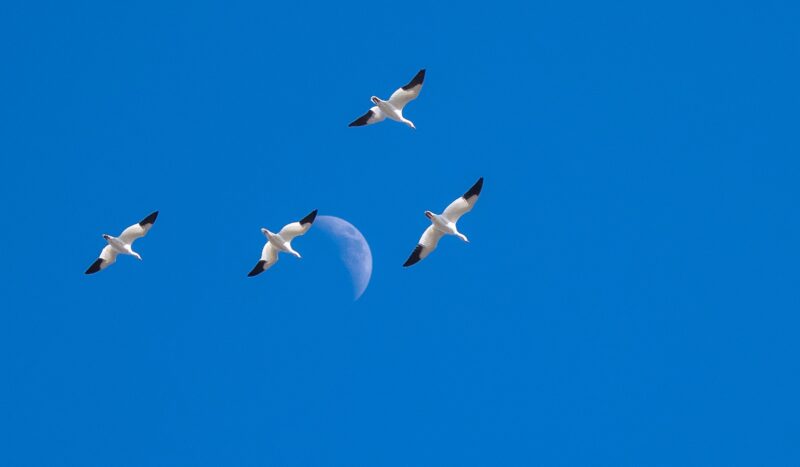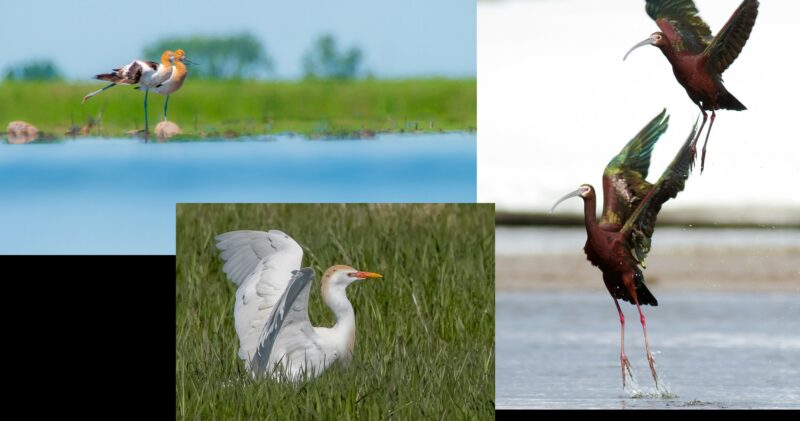
How a flood mitigation project almost 30 years in the making became an overnight success
Lisa Johnson for Upstream
Snow geese and the moon at the North Ottawa Impoundment, 2021-03-19 ©Sparky Stensaas/thephotonaturalist.com
The first time naturalist Mark “Sparky” Stensaas traveled to the North Ottawa Impoundment he’d heard so much about on social media and eBird, he was disappointed. “It didn’t look like much,” he recalls of that 2019 visit to 12 miles of collection channels dug into the prairie. “But that’s the thing regarding habitat: it doesn’t have to look like much to humans; it has to look good to the birds. That is the lesson of North Ottawa, and it wasn’t even built for that purpose. You build it, provide the proper structure for the habitat: shallow water with emergent vegetation, like cattails. That makes it highly desirable for migrating ducks and marsh birds. It might not look like much, but the numbers of birds that get attracted there are phenomenal.”
Indeed, from the project’s inception in 1988, right up to its completion in 2016, no one was thinking about anything but flood damage reduction in the 320 square mile Rabbit Run Watershed in Grant and Ottertail counties. The two thousand acres of land that make up the Impoundment are bounded by concrete dikes along the perimeter, a collection system to bring water into it and a series of partitions within it, providing 1600 acres of gate-controlled storage to reduce spring run-off into the Boise de Sioux River at Wahpeton-Breckenridge. The Impoundment reduced sedimentation and nutrients from the water by farmlands in its interior and adds a constant flow of water to the Rabbit River, which typically has little or no flow in the summer and fall.
Stalled for decades

Flood mitigation projects like the North Ottawa Impoundment were stalled for decades due to permitting issues at the State level. Jamie Beyer, administrator of the Bois de Sioux Watershed District, explains, “The people at the table at the time entered into a mediation agreement that said we’re going to build these projects – and if they meet certain criteria – they’ll qualify for 50% state cost-share. And you have the option of adding features to qualify for 75% state cost-share, if you include additional features like “natural resource enhancements” (NREs). North Ottawa is one of only four projects in the state that has qualified for that 75% cost-share.”
“Easily one of the best wetlands in all of Minnesota”
In his newly-revised 5th edition of A Birder’s Guide to Minnesota, naturalist, educator and author Kim Eckert writes:
“Looking at Grant County specifically, its western quarter still lies within the grip of Red River Valley agriculture, but there are some interesting wetlands in northwestern Grant. Of course, the most significant is the North Ottawa Impoundment – arguably, the best birding site in the SW sub-region, and easily one of the best wetlands in all of Minnesota.
“Look especially for waterfowl, grebes, shorebirds (30+ species reported!), gulls and terns, and waders. The more unusual finds have been Black-bellied Whistling Duck, King Rail (nested in 2017), Black-necked Stilt, Snowy Plover, Whimbrel, Red Knot, Little Blue Heron, Yellow-crowned Night-Heron, White-faced and Glossy Ibis.
“More than 200 species have been seen in all, which is pretty remarkable since North Ottawa has few trees around the edges. Some of the more unusual land bird sightings have been both Sharp-tailed Grouse and Greater Prairie-Chicken, Prairie Falcon, Loggerhead Shrike, Henslow’s and Nelson’s sparrows, and Great-tailed Grackle.”
A Birder’s Guide to Minnesota, Kim Eckert, Newly revised 5th edition
“Kind of a treasure”
Stensaas, a renowned photonaturalist, author, and publisher, recalls hearing about the Impoundment first through social media accounts of people who track bird sightings in Minnesota by county, and on eBird, a website and app that lets birders enter when, where, and how they went birding, and then fill out a checklist of all the birds seen and heard during the outing. With his home base in northeastern Minnesota’s Carlton County, Stensaas was used to the tourism draw of Duluth’s Hawk Ridge Bird Observatory and Meadowland’s Sax-Zim Bog, but finding some of the rare species he’s seen at the Impoundment proved a delightful surprise.

(left) American Avocets at the North Ottawa Impoundment, 2020-06-12 (center) Cattle Egret (right) White-faced Ibis. ©Sparky Stensaas/thephotonaturalist.com
“(I saw) a pair of American avocets that were obviously going to nest; I had a snowy egret there, a cattle egret, and then the masses of snow geese and greater white-fronted geese – those are some of my peak experiences. It’s amazing how quickly it became a prime destination.
(Stensaas documented some of those experiences in photographs and videos. Goose-a-Palooza HUGE Migration FIVE species of Geese is available on YouTube as is 500-mile daytrip Birding Minnesota June 12: Egret Rookery, Avocets, Western Grebes)
“They have that nice kiosk at North Ottawa that I always stop and look at every time, and that little observation overlook, so they’ve done things for the birders and curious people. More and more they’ve realized this is kind of a treasure,” he says.
Grant County’s best-kept secret tourist destination
So how did a public utility become the darling of birders and naturalists all across the region? Jamie Beyer says, frankly, it took them by surprise, too.
“The facility is 35 miles from our office” she says, a hint of wonder still in her voice after six years. “It isn’t as if you schedule an appointment to go to the Impoundment and no one “checks in,” so we never really know until we see the pictures that there’s been a bus or something like that! We really don’t have a handle on how many people visit the Impoundment or use it, apart from the pictures we see on Facebook like everybody else.”
Phase 1 of the next project, the Mustinka River Rehabilitation and Redpath Flood Impoundment is completed, but it will be quite a bit different and informed by lessons learned from North Ottawa.
“The second impoundment is being built about eight miles south in Redpath township,” explains Beyer. “This year, we’re going to be digging out a portion of the Mustinka River and re-meandering it and the material that gets excavated from the channel will be reused to build a portion of the levee wall.
“Redpath is very different, design-wise. It’s an off-channel impoundment. So a low flow will be guaranteed into the Mustinka River and to carry downstream, and then flows above and beyond that, like in the spring, will be siphoned off and fill the impoundment.
“North Ottawa is hugely expensive to operate because of all those mechanics of the individual cells and the gates and all that. Redpath doesn’t have that; it’s one big cell that will fill from the west to the east and it will have an outlet channel.
“Five of the (North Ottawa Impoundment) cells are used for revenue to pay for the Impoundment, to generate maintenance income. And then there are some structural constraints, too: two of the southeastern-most cells pretty much stay wet all year long. Of the eight interior cells, it pretty much leaves only one cell to figure out what to do with and, last year, that’s the cell they planted Japanese millet in. The project team just heard a presentation from a gentleman who grows wild rice in northern Minnesota and the DNR was interested in hearing what that could bring to the facility.”
That’s good news for Stensaas, who has his own ideas about tweaks to North Ottawa. “I think the one thing that would put North Ottawa on the map for out-of-state birders would be if some of those sections were turned back into grassland,” he says. “If there was some upland prairie where they could get short-eared owls, marbled godwit, some of those prairie birds, you wouldn’t need more than a couple of sections.”
“I think that’s pretty magical”

Greater white-fronted geese at the North Ottawa Impoundment, 2021-03-19 ©Sparky Stensaas/thephotonaturalist.com
Grassland or not, the lure of North Ottawa is irresistable to Stensaas.
“Greater white-fronted geese used to be quite rare in the state,” he says. “I think they’ve shifted their migration pattern to the east a bit. Now it’s just a treat to see these massive flocks of white-fronted geese heading up to the tundra. For me, the white-fronted geese are extra-special since they used to be so rare.
“I think the highlight during the goose migration is just the sounds – they’re just amazing and sometimes even more spectacular than the sight. You get those big flocks going overhead – I think that’s pretty magical.”
Additional Resources:
North Ottawa Impoundment photo gallery at ThePhotoNaturalist
North Ottawa Impoundment on eBird
North Ottawa Impoundment Visitor’s Guide
North Ottawa Impoundment Natural Resource Enhancements
Phase One is Done! A video highlighting 2022 construction on the Mustinka River project
The Redpath Project
The Bois de Sioux Watershed District